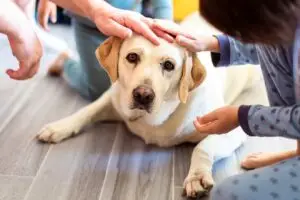Separation anxiety can be the root of many unwanted dog behaviors, such as chewing on doors and furnishings or perhaps barking or howling when their family members are gone. While this behavior is troubling, the good news is that dog separation anxiety training in Owasso can curb these issues and boost your dog’s comfort and confidence.
What Are Some Symptoms of Dog Anxiety?
With dogs, separation anxiety manifests as a variety of behavioral issues and distress signals when they are apart from their owners or primary caregivers. The severity and types of symptoms can vary, but here are some common indicators:
- Over-Dependency: Such dogs often exhibit increased clinginess, constantly following their owners around and showing signs of distress when they prepare to leave.
- Exaggerated Greeting Behaviors: Upon the owner’s return, these dogs might display overly excited greetings, far more intense than typical behavior.
- Destructive Actions: Affected dogs might gnaw on furniture, chew doorframes, dig near entrances, or ruin household items, typically shortly after their owner departs.
- Attempts to Flee: A dog trying to escape its confined space during solitude is a notable sign, which could potentially lead to injuries like broken teeth or damaged paws.
- Persistent Barking: A dog suffering from separation anxiety may engage in continuous barking, howling, or whining when alone, differing in intensity and tone from their usual vocalizations.
- Repetitive Pacing: It’s not uncommon for dogs with this anxiety to walk back and forth in a set pattern when they’re by themselves.
- Additional Signs of Stress: Excessive drooling, salivation, or panting can be visible signs of a dog’s anxiety and stress.
- Altered Eating Patterns: Dogs with separation anxiety might lose their appetite in the absence of their owner, refusing even their favorite treats.
- Indoor Bathroom Accidents: Even well-house-trained dogs might have incidents of urinating or defecating inside the house in the owner’s absence, indicating stress rather than lack of training.
In such cases, additional potty training or crate training might be beneficial, with some dogs finding comfort in a crate when left alone. In more severe cases, dogs might even defecate and then consume the excrement as a stress response, this is known as coprophagia. Potty training can be included in our dog separation anxiety training in Owasso if needed.
Causes Of Separation Anxiety
Dogs naturally prefer the company of their human companions, but not every dog shows separation anxiety symptoms when apart from their owners. This anxiety is notably prevalent in rescue dogs or those who have undergone some form of trauma. Here are several key factors that often contribute to the development of separation anxiety in dogs:
- Separation at a Young Age: Puppies weaned too early from their mothers and littermates are at a higher risk of developing separation anxiety. Dogs that have been through multiple homes or shelter experiences are also susceptible.
- Distressing Experiences: Events like getting lost or extended stays in a shelter can be distressing and lead to separation anxiety.
- Excessive Bonding: Dogs that are overly pampered or not encouraged to be self-reliant may develop separation anxiety.
- Abrupt Changes in Routine: Dogs accustomed to constant companionship may struggle with sudden long periods of solitude, leading to anxiety.
- Disruptions in Daily Life: As creatures of routine, dogs can become anxious due to major shifts in their daily lives, like a family member moving away, relocating to a new home, or a change in the owner’s work schedule.
- Insufficient Socialization or Alone-Time Training: Dogs that aren’t accustomed to being alone or lack socialization may display symptoms of separation anxiety.
- Loss of a Close Companion: The loss or absence of a key figure in a dog’s life, whether due to death or moving away, can trigger separation anxiety, particularly if that individual was the dog’s main caregiver or friend.
- Aging Issues: As dogs age, they may develop separation anxiety, often linked to cognitive decline or confusion that comes with advancing years.
- Inherent Tendencies: Certain dog breeds or individuals may have a natural inclination towards anxiety, including separation anxiety, which can be influenced by their genetic makeup.
- Health-Related Causes: Sometimes, separation anxiety can stem from underlying health issues. Physical pain or discomfort can heighten a dog’s anxiety, particularly when left alone. In such cases, addressing the health problem rather than training might resolve the behavioral issues.
How Tip Top K9 Can Help
Individualized dog training in Owasso is a crucial tool for combating separation anxiety in dogs. While there are countless online resources with various tips and methods, dealing with separation anxiety often requires the expertise of a professional dog behaviorist. They can evaluate both your dog and your home environment to craft a more effective approach.
Each dog is different, and their anxiety manifests in unique ways. At Tip Top K9, an experienced professional dog trainer will visit your home, discuss the challenges you’re facing, observe your dog’s behavior, and devise a personalized training program. This plan will address not only the separation anxiety but any other behavioral issues that may need attention.
Our training solutions range from in-home dog behavior training classes in Owasso to a more immersive dog boot camp in Owasso. The latter involves an intensive stay where your dog lives with a trainer for several weeks, ideal for dogs with more severe behavioral challenges. Our trainers will guide you in selecting the most appropriate program for your dog and family’s needs.
Remember, our expertise extends beyond separation anxiety. Whether it’s a dog that jumps on people, ignores recall commands, or pulls on the leash, our training is designed to effectively address these behaviors. We also focus on training dog owners, ensuring they have the skills to maintain positive behaviors post-training.
Our commitment to your dog’s behavior improvement doesn’t stop after the initial training. Most of our packages include lifetime access to group dog training classes in Owasso. These sessions are perfect for maintaining and enhancing good behaviors, refreshing obedience skills, and providing an excellent opportunity for your dog to burn off energy and socialize with other dogs.
Book Your First Lesson Now!
If you have a problem dog and need dog separation anxiety training in Owasso or any type of intensive dog training in Owasso, Tip Top K9 offers the best dog trainers in Oklahoma. In fact, we are the top-rated dog trainers in the United States, with more than 7.500 5-star reviews. Your first lesson is just $1 and there’s no obligation to continue, but we truly believe that we can help most dogs with anxiety, aggression, obedience issues and other problem behavior.



